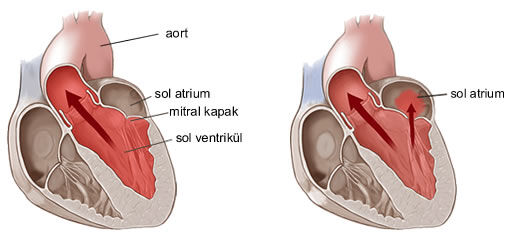https://www.youtube.com/watch?v=eeJlF4GP4do
The mitral valve is located between the left atrium and left ventricle and consists of 2 leaflets (bicuspid). Oxygen-laden blood from the lungs enters the left atrium through the pulmonary veins and from there passes through the mitral valve and flows into the left ventricle. The left ventricle then contracts and pumps blood into the aorta to distribute it throughout the body. At this point, the mitral valve closes and the aortic valve opens to prevent backflow of blood into the left atrium. Typically the mitral valve area is 4-6 cm2. If valve stenosis occurs, the valve area narrows, making it difficult for blood to flow from the left atrium to the left ventricle.
İçindekiler Tablosu
What are Mitral Valve Diseases?
Mitral Stenosis: The size of the mitral valve is approximately 4 to 6 cm². In mitral stenosis, the valve area narrows, making it difficult for blood from the left atrium to flow into the left ventricle. Diagnosed by echocardiography (ECHO) mitral stenosisIt is caused by sclerosis of the valve or subvalvular tissue. Therefore, the opening and closing function of the mitral valve is limited. In this condition, which causes blood to accumulate in the lungs, stagnation occurs in the lungs and the pressure rises. This causes the exchange of oxygen and carbon dioxide to be interrupted. Heart When it contracts, the mitral valve closes to prevent blood from returning to the left atrium. When the heart relaxes, the valves open and allow clean blood to flow from the left atrium into the left ventricle. Mitral valve prolapse is the protrusion of one or both valves of the mitral valve into the left atrium during systole.
Mitral Insufficiency: In the presence of mitral regurgitation (MR), which is characterized by the inability of the mitral valve to close completely during contraction of the left ventricle, blood flows back into the left atrium. For this reason, some of the blood that needs to be pumped into the aorta enters the aorta and some returns to the left atrium. Mitral regurgitation diagnosed by echocardiography or angiography was also graded. Mitral insufficiency, rheumatic heart disease, trauma, heart attack, endocarditis, mitral valve prolapse, congenital causes, etc. occurs depending on factors. However, mitral regurgitation is a rare disease due to rheumatic heart disease alone. Mitral valve prolapse is one of the common causes of mitral regurgitation in developed countries.
Mitral Prolapse (collapse or prolapse of the mitral valve): When the heart contracts, the mitral valve closes to prevent blood from returning to the left atrium. When the heart relaxes, the valves open and allow clean blood to flow from the left atrium into the left ventricle. Mitral valve prolapse is the protrusion of one or both valves of the mitral valve into the left atrium during systole. When the heart relaxes, the valves open and allow clean blood to flow from the left atrium into the left ventricle. Mitral valve prolapse is the protrusion of one or both valves of the mitral valve into the left atrium during systole.

Symptoms in Mitral Stenosis Diseases
Shortness of breath, heart palpitations, arrhythmia, chest pain, fainting, swelling in the legs, vomiting blood and inability to lie down may be symptoms of heart valve disease. Many of these symptoms often occur at the same time. Identifying the symptoms of heart valve disease is important in surgical decision-making.
Treatment
For general features of the treatment of valve diseases; As I mentioned above in MD, there is nothing to complain about as long as the eyelid surface does not fall below 2.5 cm2. At this stage, only preventive antibiotics are given. Sodium restriction and diuretics are used to relieve or reduce shortness of breath that occurs when valve space becomes narrow. When the surface is smaller than 1.5 cm2, drug intervention is required. Two methods are applied for this purpose:
mitral Balloon valvuloplasty (MBV): First assess the patient's suitability for this approach. This can be done if the physical properties of the valve are suitable and there is no clot in the left atrium. In this method, a special balloon is used to reach the inguinal vein and expand the valve without surgery. For this, it is sufficient for the patient to stay in the hospital for a few days.
Surgery: If the valve is not suitable for MBV, surgery is required. In this method, if the valve is not too deformed, its adhesions are opened and expanded. However, if its structure is severely damaged, it is replaced and an artificial valve (prosthesis) is placed.


